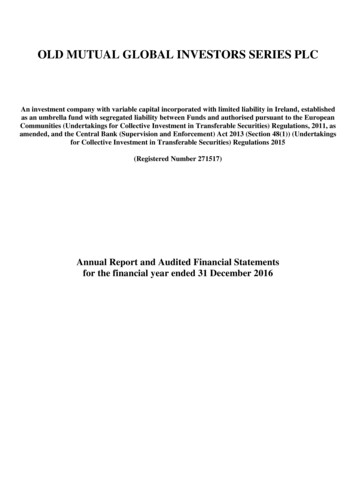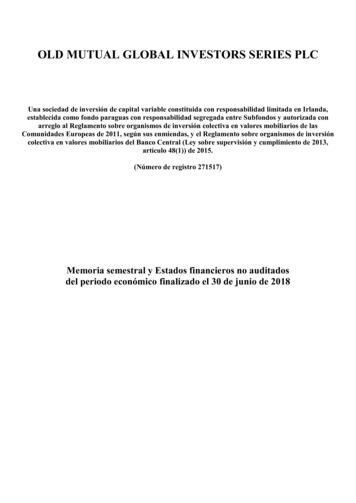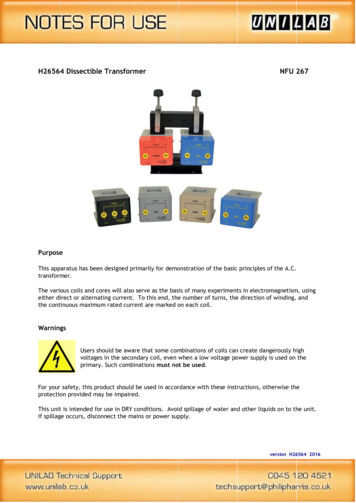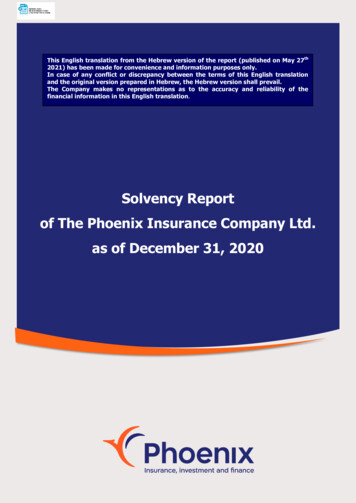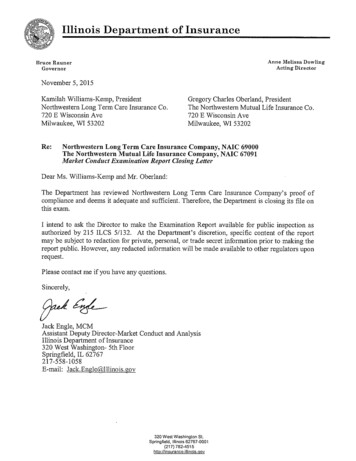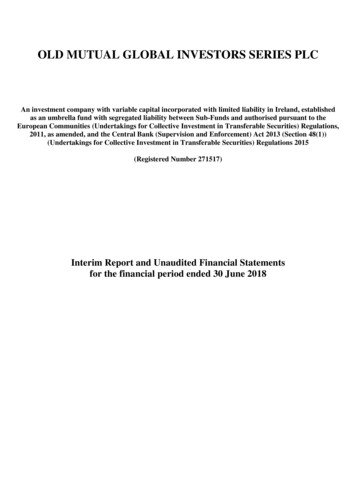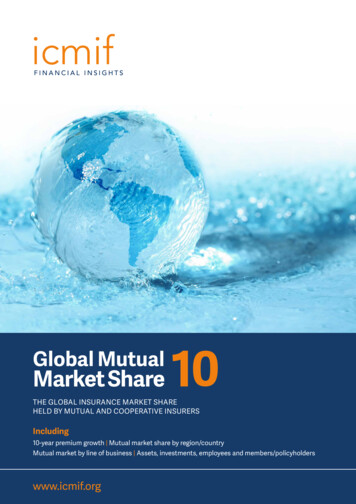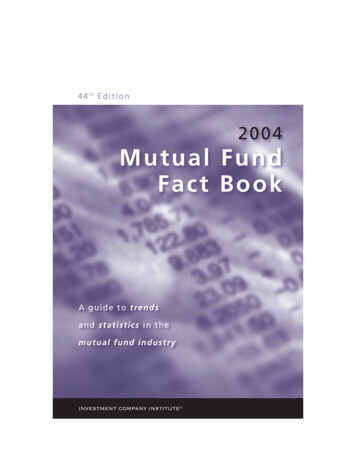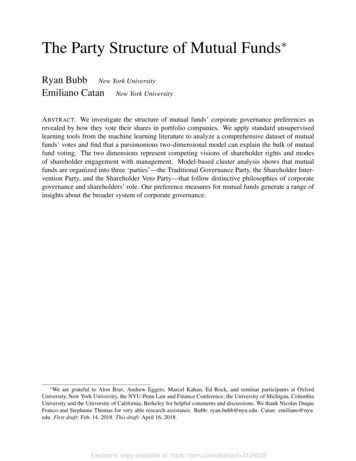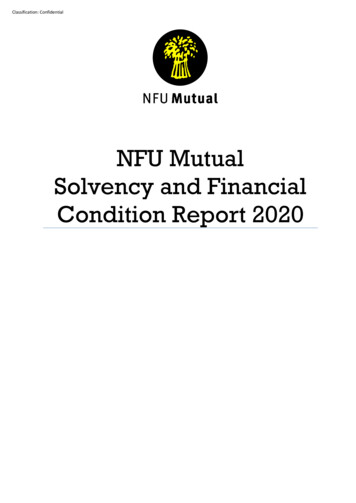
Transcription
Classification: ConfidentialNFU MutualSolvency and FinancialCondition Report 2020
Classification: Confidential
Classification: ConfidentialSolvency and Financial Condition ReportCONTENTSINTRODUCTIONSTATEMENT OF DIRECTORS’ RESPONSIBILITIES 1AUDITORS' REPORT AND OPINION . . 2SUMMARYBusiness and Performance. . 9System of Governance . . 9Risk Profile . . 9Valuation for Solvency Purposes . 10Capital Management . 10A.BUSINESS AND PERFORMANCEA.1.A.2.A.3.A.4.A.5.B.SYSTEM OF .C.Business Overview . . .12Performance of Underwriting Activities . 17Performance of Investment Activities . 18Performance of Other Activities . 19Any Other Disclosure. 20Governance Structure . 21Fit and Proper Requirements . . . . 27Risk Management System . . . 29Own Risk and Solvency Assessment . . . . 33Internal Control Function . . 35Internal Audit Function . 36Actuarial Function . 37Outsourcing . 37Adequacy of the Governance Structure .38Other Disclosures . 38RISK g Risk . 39Market Risk . 42Credit Risk . 45Liquidity Risk . 46Operational Risk . 48Other Material Risk . 51Prudent Person Principle . 52Any Other Disclosures . . 54
Classification: ConfidentialD.VALUATION FOR SOLVENCY PURPOSESD.1.D.2.D.3.D.4.D.5.E.Assets . 55Technical Provisions . 57Other Liabilities. 88Alternative Methods for Valuation . 89Any Other Disclosures. 90CAPITAL MANAGEMENTE.1.E.2.E.3.E.4.E.5.E.6.Own Funds . 91Solvency Capital Requirement (SCR)/ Minimum Capital Requirement (MCR) . . 94Use of a Duration Based Equity Risk Sub-Module in Calculating SCR . 98Internal Model Details . 98Non-Compliance with the MCR and Significant Non-Compliance with the SCR 101Any Other Disclosures. 101
Classification: ConfidentialINTRODUCTIONThis is a single SFCR that incorporates consolidated information at the level of the Group(“Group”), solo information for National Farmers Union Mutual Insurance Society Limited(“NFU Mutual”) and the subsidiary insurance undertaking: Avon Insurance Plc (“Avon”). TheGroup covers regulated, ancillary and other insurance and reinsurance companies. These aredetailed in Section A.1.e.This report is prepared as a single Group SFCR in compliance with a waiver granted by thePrudential Regulation Authority (PRA).Relevant information about the business of the Group is provided in the Group’s Annual Reportand Accounts for the year ended 31 December 2020 (the ‘Report & Accounts’), a copy of whichcan be found at nfumutual.co.uk.NFU Mutual Insurance Society is both an authorised composite insurer and the legal entity atthe head of the NFU Mutual Group. Therefore where 'NFU Mutual' is used within this documentit refers to both the insurer and the Group unless otherwise stated.STATEMENT OF DIRECTORS’ RESPONSIBILITIESApproval by the Board of Directors of the single Group Solvency and Financial ConditionReport Financial period ended 31 December 2020.We certify that:1. the Solvency and Financial Condition Report (“SFCR”) has been properly prepared in allmaterial respects in accordance with the PRA rules and Solvency II Regulations; and;2. we are satisfied that:(a) throughout the financial year in question, NFU Mutual has complied in all material respectswith the requirements of the PRA rules and Solvency II Regulations as applicable at the level ofthe Group and the insurers that form part of the Group and;(b) it is reasonable to believe that, at the date of the publication of the Solvency FinancialCondition Report, the Group has continued to comply, and will continue so to comply infuture.Signed on behalf of the Board of DirectorsJim McLarenChairmanNick TurnerGroup Chief Executive22nd April 20211
Classification: ConfidentialREPORT OF THE EXTERNAL INDEPENDENT AUDITOR TO THE DIRECTORS OF THE NATIONAL FARMERSUNION MUTUAL INSURANCE SOCIETY (‘THE COMPANY’) PURSUANT TO RULE 4.1 (2) OF THE EXTERNALAUDIT CHAPTER OF THE PRA RULEBOOK APPLICABLE TO SOLVENCY II FIRMSReport on the Audit of the relevant elements of the Group Solvency and Financial Condition Report(“SFCR”)OpinionExcept as stated below, we have audited the following documents prepared by the Company as at 31 December2020: the ‘Valuation for Solvency Purposes’ and ‘Capital Management’ sections of Group SFCR as at 31December 2020, (‘the Narrative Disclosures subject to audit’);Group templates S.02.01.02, S.22.01.22, S.23.01.22 and S.32.01.22 (‘the Group Templates subject to audit’)and,Solo templates S.02.01.02, S.12.01.02, S.17.01.02, S.22.01.21, S.23.01.01 and S.28.02.01 in respect of theGroup and Solo templates S.02.01.02, S.17.01.02, S.23.01.01, S.25.01.21(‘the Solo Templates subject toaudit’).The Narrative Disclosures subject to audit and the Group Templates and Solo Templates subject to audit arecollectively referred to as the ‘relevant elements of the Group SFCR’.We are not required to audit, nor have we audited, and as a consequence do not express an opinion on the OtherInformation which comprises:o information contained within the relevant elements of the Group SFCR set out above which is, or derivefrom the Group and Company’s Solvency Capital Requirement, as identified in the Appendix to thisreport;o the ‘Executive Summary’, ‘Business and performance’, ‘System of governance’ and ‘Risk profile’ elementsof the Group SFCR;o Group templates S.05.01.02, S.05.02.01, and S.25.02.22;o Solo templates S.05.01.02, S.05.02.01, and S.25.02.21 in respect of the Company and;o Solo templates S.05.01.02, S.05.02.01 and S.19.01.21 in respect of Avon Insurance plc;o Information calculated in accordance with the previous regime used in the calculation of the transitionalmeasures on technical provisions, and as a consequence all information relating to the transitionalmeasures on technical provisions as set out in the Appendix to this report for the Group and theCompany;o the written acknowledgement by management of their responsibilities, including for the preparation ofthe SFCR (‘the Responsibility Statement’); ando Information which pertains to an undertaking that is not a Solvency II undertaking and has beenprepared in accordance with PRA rules other than those implementing the Solvency II Directive or inaccordance with an EU instrument other than the Solvency II regulations (‘the sectoral information’).To the extent the information subject to audit in the relevant elements of the Group SFCR includes amounts thatare totals, sub-totals or calculations derived from the Other Information, we have relied without verification onthe Other Information.In our opinion, the information subject to audit in the relevant elements of the Group SFCR of the Company as at31 December 2020 is prepared, in all material respects, in accordance with the financial reporting provisions ofthe PRA Rules and Solvency II regulations on which they are based, as modified by relevant supervisorymodifications, and as supplemented by supervisory approvals and determinations.Basis for opinionWe conducted our audit in accordance with International Standards on Auditing (UK) (ISAs (UK), including ISA(UK) 800 and ISA (UK) 805, and applicable law. Our responsibilities under those standards are further describedin the Auditor’s Responsibilities for the Audit of the relevant elements of the Group Solvency and FinancialCondition Report section of our report. We are independent of the Group in accordance with the ethicalrequirements that are relevant to our audit of the Group SFCR in the UK, including the Financial ReportingCouncil’s (the ‘FRC’s’) Ethical Standard as applied to public interest entities, and we have fulfilled our otherethical responsibilities in accordance with these requirements. We believe that the audit evidence we haveobtained is sufficient and appropriate to provide a basis for our opinion.2
Classification: ConfidentialEmphasis of Matter – Basis of AccountingWe draw attention to the ‘Valuation for Solvency Purposes’ and ‘Capital Management’ sections of the GroupSFCR, which describe the basis of accounting. The Group SFCR is prepared in compliance with the financialreporting provisions of the PRA Rules and Solvency II regulations, and therefore in accordance with a specialpurpose financial reporting framework. The Group SFCR is required to be published, and intended users includebut are not limited to the PRA. As a result, the Group SFCR may not be suitable for another purpose. Our opinionis not modified in respect of these matters.Conclusions relating to going concernIn auditing the financial statements, we have concluded that the Directors’ use of the going concern basis ofaccounting in the preparation of the Group SFCR is appropriate.Our evaluation of the directors’ assessment of the Group’s ability to continue to adopt the going concern basis ofaccounting includes the following procedures;o Inquiring of senior management in relation to their going concern assessment including impacts ofCovid-19 and Brexit, and the steps they will take in the event that economic and other factorsdeteriorate further due to government-imposed lockdowns;o Challenging management’s key assumptions underpinning the going concern basis of accounting, byassessing the reasonableness of significant movements in forecast cash flows and considering theirconsistency with other available information and our understanding of the group businesses. Thisincluded inspecting and challenging management's stress scenario testing and reverse stress testing. Wealso challenged whether the future forecasts and assumptions were used consistently across thepreparation of the SFCR;o Evaluating the historical accuracy of forecasts made by management by comparing them to actualresults;o Assessing the group’s operational resilience, business continuity plans, monitoring of outsourcedoperations, and ability to continue to serve customers, comply with regulations and maintainappropriate internal controls as this relates to the ability to continue as a going concern; ando Evaluating the appropriateness of disclosures in the 2020 SFCR relating to going concern and theprincipal risks and uncertainties that the group and parent company faces, with particular focus onCovid-19 and Brexit.Based on the work we have performed, we have not identified any material uncertainties relating to events orconditions that, individually or collectively, may cast significant doubt on the Group’s ability to continue as agoing concern for a period of at least twelve months from when the SFCR is authorised for issue.Other InformationThe Directors are responsible for the Other Information.Our opinion on the relevant elements of the Group SFCR does not cover the Other Information and we do notexpress an audit opinion or any form of assurance conclusion thereon.Our responsibility is to read the Other Information and, in doing so, consider whether the Other Information ismaterially inconsistent with the relevant elements of the Group SFCR, or our knowledge obtained in the courseof the audit, or otherwise appears to be materially misstated. If we identify such material inconsistencies orapparent material misstatements, we are required to determine whether there is a material misstatement in therelevant elements of the Group SFCR themselves. If, based on the work we have performed, we conclude thatthere is a material misstatement of this Other Information, we are required to report that fact.We have nothing to report in this regard.Responsibilities of Directors for the Group Solvency and Financial Condition ReportThe Directors are responsible for the preparation of the SFCR in accordance with the financial reportingprovisions of the PRA rules and Solvency II regulations which have been modified by the modifications, andsupplemented by the approvals and determinations made by the PRA under section 138A of FSMA, the PRARules and Solvency II regulations on which they are based.3
Classification: ConfidentialThe Directors are also responsible for such internal control as they determine is necessary to enable thepreparation of a Group SFCR that is free from material misstatement, whether due to fraud or error.Auditor’s Responsibilities for the Audit of the relevant elements of the Solvency and Financial ConditionReportIt is our responsibility to form an independent opinion as to whether the relevant elements of the Group SFCRare prepared, in all material respects, with financial reporting provisions of the PRA Rules and Solvency IIregulations on which they are based.Our objectives are to obtain reasonable assurance about whether the relevant elements of the Group SFCR arefree from material misstatement, whether due to fraud or error, and to issue an auditor’s report that includesour opinion. Reasonable assurance is a high level of assurance, but it is not a guarantee that an audit conductedin accordance with ISAs (UK) will always detect a material misstatement when it exists. Misstatements can arisefrom fraud or error and are considered material if, individually or in the aggregate, they could reasonably beexpected to influence the decision making or the judgement of the users taken on the basis of the Group SFCR.A further description of our responsibilities for the audit of the financial statements is located on the FRC’swebsite at https://www.frc.org.uk/auditorsresponsibilities. The same responsibilities apply to the audit of theGroup SFCR.Extent to which the audit was considered capable of detecting irregularities, including fraudIrregularities, including fraud, are instances of non-compliance with laws and regulations. We design proceduresin line with our responsibilities, outlined above, to detect material misstatements in respect of irregularities,including fraud. The extent to which our procedures are capable of detecting irregularities, including fraud isdetailed below.We considered the nature of the Group’s industry and its control environment, and reviewed the Group’sdocumentation of their policies and procedures relating to fraud and compliance with laws and regulations. Wealso enquired of management and internal audit about their own identification and assessment of the risks ofirregularities.We obtained an understanding of the legal and regulatory frameworks that the Group operates in, and identifiedthe key laws and regulations that:oohad a direct effect on the determination of material amounts and disclosures in the Group SFCR. Theseincluded Solvency II as implemented in the UK and pensions and tax legislation; anddo not have a direct effect on the SFCR but compliance with which may be fundamental to the Group’sability to operate or to avoid a material penalty. These included Companies Act 2006 and relatedCompany Law, the Prudential Regulatory Authority and Financial Conduct Authority regulations, thegroup companies’ operating licences and regulatory solvency requirements.We discussed among the audit engagement team including relevant internal specialists such as tax, actuarial,valuations, pensions, IT and industry specialists regarding the opportunities and incentives that may exist withinthe organisation for fraud and how and where fraud might occur in the SFCR.As a result of performing the above, we identified the greatest potential for fraud in the following areas, and ourspecific procedures performed to address them are described below:Appropriateness of base mortality and mortality improvements assumptions used to value the life insuranceliabilities We obtained an understanding of the relevant controls around life reserving annuitant mortalitymethodology and assumptions in place to mitigate the risk of inappropriate assumptions being used invaluing the long-term business provision; We evaluated the in-year experience study relating to base annuitant mortality experience across thematerial annuity products; We challenged key judgements made around adopted annuitant mortality improvement assumptions bymaking reference to the latest available CMI 2019 mortality improvements model and considered theappropriateness of fit to the underlying book ; We inspected and validated supporting evidence for any adjustments made to the latest availableindustry table CMI 2019 models to assess whether the adjustments are appropriately supported byevidence;4
Classification: Confidential Where appropriate, we have compared the assumptions selected by management to those used by peerannuity companies.Appropriateness of the latent reserving assumptions and methodology used for the valuation of generalinsurance liabilities We obtained an understanding of the relevant controls in place to mitigate the risk of inappropriateassumptions being used in valuing the general business latent reserves; We challenged management’s documented model methodology, and documented approach to derivingmaterial latent assumptions; We challenged management’s process for commissioning third party reports and challengedmanagement on the up-to-date completeness of information used to inform assumptions underlying thebest estimate; We inspected the methodology for calculating exposure ranges for latent claims and where possibleagreed this data back to audited policyholder data to corroborate management judgements; We challenged management’s sensitivity testing on key assumptions. We challenged these sensitivitiesby assessing the rationale for each and the range of sources considered in the selection of each of theseassumptions; and We challenged management’s process for eliminating redundant latent reserves where exposure and thelikelihood of claim occurrence are trending downwards.Appropriateness of the non-latent assumptions and methodology used for the valuation of general insuranceliabilities We obtained an understanding of the relevant controls in place to mitigate the risk of inappropriateassumptions being used in valuing the general business non-latent reserves. We challenged management’s selection of applied methodology and assumptions, focusing on materialclasses of business in relation to TPBI for claims above 1m; We assessed the documented methodology and assumptions used by management to calculate the nonlatent reserves, including graphical review testing of methodology weighting and management’sapplication outputs using our in-house reserving software, and where applicable comparison to industrystandard practices; and We performed independent re-projections for a sample of classes and perils in relation to TPBI claimsabove 1m.In common with all audits under ISAs (UK), we are also required to perform specific procedures to respond tothe risk of management override. In addressing the risk of fraud through management override of controls,testing the appropriateness of journal entries and other adjustments; assessing whether the judgements made inmaking accounting estimates are indicative of a potential bias; and evaluating the business rationale of anysignificant transactions that are unusual or outside the normal course of business.In addition to the above, our procedures to respond to the risks identified included the following:ooooreviewing SFCR disclosures by testing to supporting documentation to assess compliance withprovisions of relevant laws and regulations described as having a direct effect on the financialstatements;performing analytical procedures to identify any unusual or unexpected relationships that may indicaterisks of material misstatement due to fraud;enquiring of management, internal audit and external legal counsel concerning actual and potentiallitigation and claims, and instances of non-compliance with laws and regulations; andreading minutes of meetings of those charged with governance and reviewing correspondence with thePrudential Regulation Authority and Financial Conduct Authority reviewing internal audit reports andreviewing correspondence with HMRC.Other MatterThe Company has authority to calculate its Group Solvency Capital Requirement using an internal model (“theModel”) approved by the Prudential Regulation Authority in accordance with the Solvency II Regulations. Informing our opinion (and in accordance with PRA Rules), we are not required to audit the inputs to, design of,operating effectiveness of and outputs from the Model, or whether the Model is being applied in accordance withthe Group’s application or approval order.5
Classification: ConfidentialReport on Other Legal and Regulatory RequirementsSectoral InformationIn our opinion, in accordance with Rule 4.2 of the External Audit Chapter of the PRA Rulebook, the sectoralinformation has been properly compiled in accordance with the PRA rules and EU instruments relating to thatundertaking from information provided by members of the Group and the relevant insurance group undertaking.Other InformationIn accordance with Rule 4.1 (3) of the External Audit Chapter of the PRA Rulebook for Solvency II firms we arerequired to consider whether the Other Information is materially inconsistent with our knowledge obtained inthe audit of the National Farmers Union Mutual Insurance Society statutory financial statements. If, based on thework we have performed, we conclude that there is a material misstatement of this other information, we arerequired to report that fact.We have nothing to report in relation to this matter.Use of our ReportThis report is made solely to the Directors of National Farmers Union Mutual Insurance Society in accordancewith Rule 4.1 (2) of the External Audit Chapter of the PRA Rulebook for Solvency II firms. We acknowledge thatour report will be provided to the PRA for the use of the PRA solely for the purposes set down by statute and thePRA’s rules. Our audit work has been undertaken so that we might state to the insurer’s Directors those matterswe are required to state to them in an auditor’s report on the relevant elements of the Group SFCR and for noother purpose. To the fullest extent permitted by law, we do not accept or assume responsibility to anyone otherthan the Group and the PRA, for our audit work, for this report or for the opinions we have formed.Mark McQueen (Senior Statutory Auditor)For and on behalf of Deloitte LLPStatutory AuditorLondon, England22 April 20216
Classification: ConfidentialAppendix – relevant elements of the Solvency and Financial Condition Report that are not subject toauditThe relevant elements of the SFCR that are not subject to audit comprise:The following elements of Group template S.02.01.02: Row R0550: Technical provisions - non-life (excluding health) - risk margin Row R0590: Technical provisions - health (similar to non-life) - risk margin Row R0640: Technical provisions - health (similar to life) - risk margin Row R0680: Technical provisions - life (excluding health and index-linked and unit-linked) - risk margin Row R0720: Technical provisions - Index-linked and unit-linked - risk marginThe following elements of Group template S.22.01.22: Column C0030 – Impact of transitional on technical provisions Row R0010 – Technical provisions Row R0090 – Solvency Capital RequirementThe following elements of Group template S.23.01.22: Row R0020: Non-available called but not paid in ordinary share capital at group level Row R0060: Non-available subordinated mutual member accounts at group level Row R0080: Non-available surplus at group level Row R0100: Non-available preference shares at group level Row R0120: Non-available share premium account related to preference shares at group level Row R0150: Non-available subordinated liabilities at group level Row R0170: The amount equal to the value of net deferred tax assets not available at the group level Row R0190: Non-available own funds related to other own funds items approved by supervisory authority Row R0210: Non-available minority interests at group level Row R0380: Non-available ancillary own funds at group levelRows R0410 to R0440 – Own funds of other financial sectors Row R0680: Group SCR Row R0740: Adjustment for restricted own fund items in respect of matching adjustment portfolios and ringfenced funds Row R0750: Other non available own fundsThe following elements of the Company’s template S.02.01.02: Row R0550: Technical provisions - non-life (excluding health) - risk margin Row R0590: Technical provisions - health (similar to non-life) - risk margin Row R0640: Technical provisions - health (similar to life) - risk margin Row R0680: Technical provisions - life (excluding health and index-linked and unit-linked) –risk margin Row R0720: Technical provisions - Index-linked and unit-linked - risk marginThe following elements of the Company’s template S.12.01.02 Row R0100: Technical provisions calculated as a sum of BE and RM - Risk margin Rows R0110 to R0130 – Amount of transitional measure on technical provisionsThe following elements of the Company’s template S.17.01.02 Row R0280: Technical provisions calculated as a sum of BE and RM - Risk margin Rows R0290 to R0310 – Amount of transitional measure on technical provisionsThe following elements of the Company template S.22.01.21 Column C0030 – Impact of transitional on technical provisions Row R0010 – Technical provisions Row R0090 – Solvency Capital RequirementThe following elements of the Company’s template S.23.01.017
Classification: Confidential Row R0580: SCR Row R0740: Adjustment for restricted own fund items in respect of matching adjustment portfolios and ringfenced fundsThe following elements of the Company template S.28.02.01 Row R0310: SCRElements of the Narrative Disclosures subject to audit identified as ‘unaudited’.8
Classification: ConfidentialSUMMARYBusiness and PerformanceThe results for the year for the Group, NFU Mutual and Avon Insurance have been:(Loss) / Profit after taxGroup m20202019(143)573NFU MUTUAL m20202019(123)578Avon m202020198.08.1The Group made a loss after tax of 143m (2019: profit of 573m) and a loss of 123m (2019: profitof 578m) for NFU Mutual on a UK GAAP basis. The General Insurance Business delivered astrong performance with an underwriting result of 109m (2019: 167m), however the overallGroup loss of 143m reflects the combined impact of underwriting profit more than offset byoverall investment returns and mutual bonus of 252m paid to our members.In respect of Avon Insurance plc, an insurance company within the group, the profit for theperiod after tax but before dividends of 8.0m (2019: profit of 8.1m) was primarily driven bystrong underwriting profits in the year.System of GovernanceThe Board of Directors of the Group has ultimate accountability for ensuring that all risks to whichthe Group is exposed are effectively managed. The Board delegates accountability for riskmanagement down through the Group’s organisation structure, to individuals and teams withappropriate expertise and capability.The Board also oversees the effectiveness of risk management via its Risk GovernanceFramework, which consists of committees from Board level to business unit and divisional leveland ensures effective Group wide risk oversight. The committees oversee the ef
UNION MUTUAL INSURANCE SOCIETY ('THE COMPANY') PURSUANT TO RULE 4.1 (2) OF THE EXTERNAL . Council's (the 'FRC's') Ethical Standard as applied to public interest entities, and we have fulfilled our other ethical responsibilities in accordance with these requirements. We believe that the audit evidence we have
